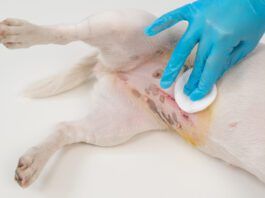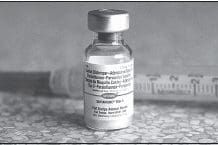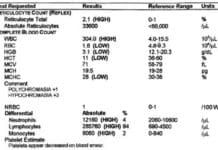Use Caution When Filling Veterinary Prescriptions at Human Pharmacies
A few years ago, I was at my vet’s office when an older couple brought in a Chihuahua puppy who was very ill. Despite the staff’s best efforts, less than an hour later the pup was dead. The cause? A drug overdose, due to a prescription error made by a human pharmacy.
Veterinary Applications of Laser Therapy
Acupuncture Points and Trigger Points: Traditional Chinese acupuncture points are stimulated by a focused laser beam, used solely or in combination with acupuncture needles, to produce a systemic effect; high doses of laser therapy may be used to deactivate trigger points (hyperirritable spots that induce pain elsewhere in the body) found in muscle, ligaments, tendons, and periosteum.
When to Seek Veterinary Care After Your Dog Has a Close Call at the...
Did Your Dog Have a Scary, Sinking Moment in the Water? “If the dog comes out and he’s fine, he’ll shake it off,” says Jules Benson, DVM. “You need to watch him for the next 24 to 48 hours, because that’s when aspiration pneumonia (caused by water going down into the main-stem bronchi) can occur. Especially if it’s water other than a pool, where there could be bacteria or protozoa in the water. If they aspirate any of that and it goes into the lungs, the bacteria spreads and multiplies.
Veterinary and Human Medical Centers Collaborate
The Virginia-Maryland Regional College of Veterinary Medicine and Wake Forest University’s Institute for Regenerative Medicine in Winston-Salem, North Carolina, signed an agreement in January to form the Virginia Tech/Wake Forest Center for Veterinary Regenerative Medicine (CVRM). The goal is to facilitate the use of cutting-edge, regenerative (stem cell) treatments for pets and people. Clinical trials performed at the center will provide valuable information concerning the effects of stem-cell therapy.
Blood Transfusions for Dogs
Denise Mankin, DVM, was on duty late one night in a Des Moines, Iowa, emergency veterinary clinic when Yeller, a Labrador Retriever, was rushed in sporting a fresh wound to his back. Yeller had been shot after escaping from his rural home. After stabilizing Yeller with IV fluids, antibiotics, and pain medications, Mankin opened up the dog's abdomen to find blood filling his abdominal cavity. A bullet had perforated Yeller's small intestine in five different locations, and two of the sites were hemorrhaging profusely. Within moments, his blood pressure plummeted. As Mankin worked desperately to tie off the blood supply to his damaged bowel, Yeller went into cardiac arrest. Cardiac drugs restored Yeller's heart beat, and donor blood, having been warmed for transfusion, was pumped into him.
Less Stressful Veterinary Visits
A training friend suggested that I read Low Stress Handling, Restraint, and Behavior Modification of Dogs and Cats, by applied animal behaviorist Sophia Yin, DVM, MS. As an owner whose dogs have taken their fair share of visits to vet clinics, I really liked what I read. Dr. Yin's text takes a critical look at how our pets are often handled in veterinary clinics and it's not pretty, as you may have seen yourself. Fortunately, she also offers common sense advice on approaching veterinary care so as to make it as stress-free as possible for our pets. Popular myths abound that force is needed to get animals to behave. Instead, Dr. Yin focuses on how to modify behavior quickly in a veterinary setting using a systematic and positive approach. Her methods involve classical conditioning to change the pet's emotional state; setting up the veterinary environment to ensure the pet's comfort; teaching us how to handle animals with appropriate, rather than stronger, restraint; and how to behave around animals so as to avoid creating problems.
Communicate With Your Veterinarian
Randy Boucher of Philadelphia took his new Rhodesian Ridgeback puppy on her first veterinary visit armed with a binder full of diet and vaccine recommendations from his holistically oriented breeder.
Shots Fired: Professional veterinary associations call for a reduced canine vaccination protocol
In the past decade, the veterinary profession’s overall attitude toward vaccination has evolved to a point that can be tentatively termed progressive. In 2002, the American Veterinary Medical Association issued a policy statement that urged veterinarians to “customize” vaccine protocols for individual patients, since there is “inadequate data to scientifically determine a single best protocol” for initial or repeat vaccinations. A year later, the prestigious American Animal Hospital Association (AAHA) released its landmark canine vaccination guidelines, which were updated in 2006.
Your Dog’s Anal Glands and Sacs
Oh, the smell! Anyone who's ever been in the same room when a frightened dog blows" her anal glands or a veterinarian manually expresses them will never forget the malodorous experience. It's wise for dog owners to be aware of the problems that can arise with these glands
Communication With Your Dog’s Vet Is Key
Have you ever known exactly what your dog wanted or needed by simply looking into his or her sweet brown eyes? Most of us have experienced this with our dogs. An owner’s insight regarding whether a dog would rather play tug or eat an early dinner may seem relatively unimportant in the greater scheme of things. But for many of us who have a close relationship with our dogs, we may have experienced that intuition on a much deeper level.
Conventional and Holistic Veterinarians Working Together
Every day the already dazzling array of options for caring for your dog grows even more. There are myriad modalities in the realm of holistic care, including complementary and alternative options, as well as conventional veterinary medicine, with its low- and high-tech diagnostic and treatment procedures. Which way do you go when your dog has a health concern?
What’s Your Dog’s Complete Blood Count (CBC) Diagnosis?
as it is expressed here) and hemoglobin (HGB) indicate a mild anemia. Based on this


















